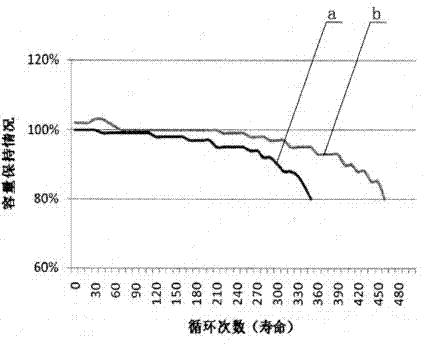Lead-acid battery container formation technology
A lead-acid battery, internalization technology, applied in the direction of lead-acid battery, lead-acid battery construction, secondary battery, etc., can solve a lot of acid mist and other problems, achieve the effect of simplifying operation, reducing environmental pollution, and reducing production cost
- Summary
- Abstract
- Description
- Claims
- Application Information
AI Technical Summary
Problems solved by technology
Method used
Image
Examples
Embodiment 1
[0039] A kind of internal formation technology of lead-acid storage battery, comprises the following steps:
[0040] Adding acid and standing still: Install the one-way sealing valve to the lead-acid battery, then add acid to the valve-controlled sealed lead-acid battery, add the electrolyte sulfuric acid quantitatively according to the volume of the separator saturation of 100%, and the battery after adding acid Cool the water bath to 35°C, let it stand for 2 hours, then cover the safety valve, and glue the battery cover, which is ultrasonically welded;
[0041] Connect the obtained accumulator to the charger for internalization, and the internalization steps are shown in Table 1;
[0042] The first stage of internalization is step 1-8; the second stage of internalization is step 9-14; the third stage of internalization is step 15-31; wherein, the density of sulfuric acid in the electrolyte is 1.32g / cm 3Adding mass fraction of 0.7% anhydrous sodium sulfate and 0.07% stannous...
Embodiment 2
[0045] A kind of internal formation technology of lead-acid storage battery, comprises the following steps:
[0046] Add acid and stand still: add acid to the lead-acid battery, add sulfuric acid in the electrolyte solution quantitatively according to the volume of the separator saturation 100%, cool the battery water bath to 45°C after acid addition, let stand for 3 hours, and then cover the safety valve. Bond the battery cover, and the battery cover is ultrasonically welded;
[0047] Connect the obtained accumulator to the charger for internalization, and the internalization steps are shown in Table 1;
[0048] The first stage of internalization is step 1-8; the second stage of internalization is step 9-14; the third stage of internalization is step 15-31; wherein, the density of sulfuric acid in the electrolyte is 1.35g / cm 3 Adding mass fraction of 1% anhydrous sodium sulfate and 0.1% stannous sulfate into the sulfuric acid; the temperature of the storage battery is me...
Embodiment 3
[0051] A kind of internal formation technology of lead-acid storage battery, comprises the following steps:
[0052] Adding acid and standing still: Install the one-way sealing valve to the lead-acid battery, then add acid to the valve-controlled sealed lead-acid battery, add the electrolyte sulfuric acid quantitatively according to the volume of the separator saturation of 100%, and the battery after adding acid Cool the water bath to 55°C, let it stand for 4 hours, then cover the safety valve, and glue the battery cover, and the battery cover is bonded with epoxy resin solution;
[0053] Connect the obtained accumulator to the charger for internalization, and the internalization steps are shown in Table 1;
[0054] The first stage of internalization is step 1-8; the second stage of internalization is step 9-14; the third stage of internalization is step 15-31; wherein, the density of sulfuric acid in the electrolyte is 1.37g / cm 3 Adding mass fraction of 1.05% anhydrous ...
PUM
| Property | Measurement | Unit |
|---|---|---|
| Density | aaaaa | aaaaa |
| Density | aaaaa | aaaaa |
| Density | aaaaa | aaaaa |
Abstract
Description
Claims
Application Information
 Login to View More
Login to View More - R&D
- Intellectual Property
- Life Sciences
- Materials
- Tech Scout
- Unparalleled Data Quality
- Higher Quality Content
- 60% Fewer Hallucinations
Browse by: Latest US Patents, China's latest patents, Technical Efficacy Thesaurus, Application Domain, Technology Topic, Popular Technical Reports.
© 2025 PatSnap. All rights reserved.Legal|Privacy policy|Modern Slavery Act Transparency Statement|Sitemap|About US| Contact US: help@patsnap.com

